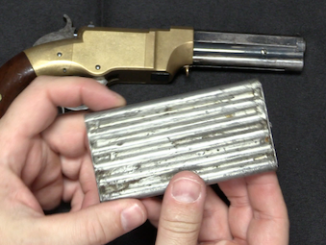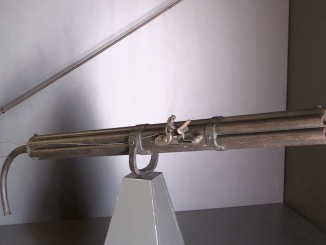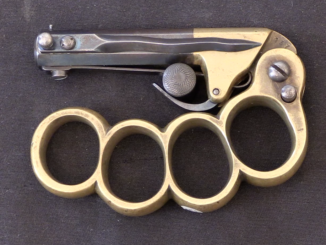Savage was very successful with their .32 ACP and .380 ACP pocket pistols, and in the 1910s was interested in also breaking into the .25 ACP market, to compete with the Colt 1908 “Baby Browning”. Savage invested in all the tooling to make a new blowback .25, but never put them into serial production. Only a few dozen were ever made, in two separate runs. Why so few? The exact reason is lost to history, but most likely the company determined that they would not be able to produce the guns at a price that would be competitive.
Today’s video is a re-make of a previous one, because I was able to get examples of both production runs to show, and also learned (thanks to master gunsmith Bill Chase) how to disassemble them! It’s quite the non-intuitive process…




“Why so few? The exact reason is lost to history, but most likely the company determined that they would not be able to produce the guns at a price that would be competitive.”
At similar time, H&R also introduced .25 automatic pistol – http://cosmolineandrust.blogspot.com/2015/01/harrington-richardson-25-self-loading.html – sales were poor. It seems that at that time there was no big American market for American-made .25 automatic pistols. Excluding Colt Model 1908 Vest Pocket, I don’t know successful US-made .25 automatic pistols from that era. I think that Savage .25 might score success in Europe, either as export product (if it might be priced not too high) or licensed for some European arm-maker.
Notice that there was example of selling European-designed .25 automatic pistols in United States: namely Phoenix automatic pistol:
http://www.collectorsfirearms.com/phoenix-arms-pocket-pistol-25-acp-pr23437/
considering from rarity on collectors market it was rather not successful.
Zhuk has only one sentence of description about it: Copy of Belgian automatic pistol “Melior”, produced in beginning of 20th century in Lowell, state Massachusetts.
Generally for me it seems that:
In 1900s US civil customers prefer revolver over automatic pistol in “pocket” category.
Can anyone deny it or prove it?
Ian
Just a few questions. 1. How did the gun feel in the hand? The magazine latch makes a forward projection at the bottom front of the grip, does it get in the way? 2. There is a small silver pin on top of the slide and behind the ejection port, that sits below the top until you ran the slide off. It jumped up, then down again, what was that for? 3. Last you said the block in the rear kept the slide from blowing off the frame during firing, wouldn’t the barrel, fixed to the frame also stop the slide?
Very mysterious as to why it didn’t make production, the prototypes look to be production ready even to the point of having grips molded in a dedicated mold, with finished graphics, and markings on the metal made by what looks like production roll dies specifically for this gun.
Thanks.
For a tiny .25″pistol, field stripping seems novel but complicated. lts simplified and more robust form was used in Walther Model9 after a decade later.
The chamber loaded indicator at top, also looks complicated and having more parts. Most importantly, trigger sear connections seems as copied from Browning’s construction used in FN 1900 and 1906 models which happens a clear patent rights infridgement. Summing them up would rise the reason for decidement of giving up its reasoable production.
“Walther Model9”
Does that apply also to Walther Model 8?
http://unblinkingeye.com/Guns/Walther7-8/walther7-8.html states that Walther Model 7 was failure commercial-wise, when Walther Model 8 was success. Easier disassembly might help in this, but for sure was not sole reason.
The Walther Model 8 had decent sight, was precise and not too small. This made it popular in pistol shooting, particularly rapid fire (7 shots in 10 sec) in the twenties and thirties, due to low recoil. This application is by the way the reason why Walther PP pistols in 6.35 mm also were made.
Only later .22 became popular, the first .22 pistol in Germany (Stock) became available in 1925.
By the way, we can read this on Wikipedia:
“The tiny cartridge [.25 ACP] has also been used in some precision crafted target pistols.” [https://en.wikipedia.org/wiki/.25_ACP]
Since I have found this, I haven’t found sources and examples so far. Will you share your knowledge?
“examples”
For .25 Auto target pistol see section titled Le Français – Champion here: http://unblinkingeye.com/Guns/Francais/francais.html
@Daweo:
I’ve forgotten to mention the only example, which I know. Are there more examples?
“Only later .22 became popular, the first .22 pistol in Germany (Stock) became available in 1925.”
Wasn’t RÖMERWERKE automatic pistol earlier?
https://books.google.pl/books?id=okQH6zFgDtUC&pg=PA268&lpg=PA268&dq=R%C3%96MERWERKE+pistole&source=bl&ots=MEHZP4l1sw&sig=DBHg14NntJRuBCyQ7k1IdHN7BMg&hl=pl&sa=X&ved=0ahUKEwjVlafs-57SAhVEKywKHf92BHoQ6AEIFDAA#v=onepage&q=R%C3%96MERWERKE%20pistole&f=false states that it was “(…)offered 22 rimfire pistols c.1925-33(…)”
“The Walther Model 8 had decent sight, was precise and not too small”
In seems that in Germany there were 2 ways of designing .25 automatic pistols: “minimalist” one leading to as small design as possible (see Mann .25 automatic pistol for example) and second which don’t pursue being as small as possible (for example Mauser Model 1910).
Walther Model8 diassembly is made through the trigger guard, like PP models, whereas the 9, does it through the striker channel back post movable on the frame like the one on this Savage pistol with a difference that, the back post plugging the striker channel and retaining the slide/breechbolt in working order, is kept in its location by a spring loaded lever.
There seem to be two patents related to this design:
https://www.google.com/patents/US1176254
https://www.google.com/patents/US1206892
Ian, Thanks for the followup!
Here is one other patent that may be related:
https://www.google.com/patents/US1165621
What interesting in this patent is, describing fluted chamber and breechbolt face to delay the opening of breechbolt back at instant of the highest pressure presenting in the barrel. The pistol should be using a powerfull round and the year of invention seems very important.
Though stirrup shaped trigger bar resembles very much to Browning’s from upside, patents reveal that its function seems quite different. lt contains the sear integrally at its rear section, but if it were produced and sued by Browning, it might rise trouble.
Patent ll76254, has an interesting friction delay mechanism actuated through the force applied on the trigger. A similar lockwork had been used in the Thomas .45″ pistol in 1971 through the actuator part being as the grip safety.
What would one with the 1000m sn
Be worth if all original?